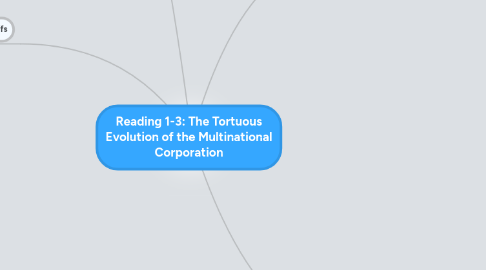
1. Costs, Risks, Payoffs
1.1. Ethnocentrism
1.1.1. Benefits
1.1.1.1. Simpler
1.1.1.2. More communication of knowhow from headquarters to new markets
1.1.1.3. More control over appointments to senior management in subsidiaries
1.1.2. Costs
1.1.2.1. Ineffective planning
1.1.2.2. Lack of good feedback
1.1.2.3. best employees in subsidiaries leave
1.1.2.4. fewer innovations
1.1.2.5. mediocre organization in the long run
1.2. Polycentrism
1.2.1. Benefits
1.2.1.1. Intense expolitation of local markets
1.2.1.2. Better sales since local management is better informed
1.2.1.3. More local initiative
1.2.1.4. More host-government support
1.2.1.5. Good local managers with high morale
1.2.2. Costs
1.2.2.1. Waste due to
1.2.2.1.1. duplication
1.2.2.1.2. decisions to make products local that could have international success
1.2.2.2. inefficient use of home-country experience
1.2.2.3. excessive regard for local traditions and local growth
1.3. Geocentrism
1.3.1. Benefits
1.3.1.1. More powerful company
1.3.1.2. Better quality of product/service
1.3.1.3. Worldwide utilization of best resources
1.3.1.4. Improvement of local company management
1.3.1.5. commitment to world-wide objectives
1.3.1.6. more profit
1.3.2. Costs
1.3.2.1. Communication and travel expenses
1.3.2.2. Educational cost
1.3.2.3. More time needed to make decisions because consensus is required
1.3.2.4. international headquarters bureaucracy
1.3.2.5. Too wide distribution of power
2. Companies try to appear geocentric
2.1. Appointing foreigners into key positions if they are incompetent
2.1.1. Window Dressing
2.2. Foreigners often have to conform to the home culture in order to succeed
2.2.1. Tokenism
3. Three primary attitudes among international executives toward building a multinational enterprise (p. 94)
3.1. Ethnocentric (Home-Country oriented)
3.1.1. "We, home nationals of X company, are superior to, more trustwprthy and more reliable than any foreigners in headquarters or subsidiaries. We will be willing to build facilities in your country if you acknowledge our inherent superiority and accept our methods and conditions for doing the job."
3.1.1.1. Never said this directly
3.1.2. Performance criteria are made in the home area
3.1.2.1. Steady top down stream of information
3.1.2.1.1. "This works at home so it will work for you"
3.1.3. National identity of home country throughout entire company
3.1.4. Employees of home country are more likely to rise in position
3.1.5. Can be found in every multinational company
3.2. Polycentric (Host-country oriented)
3.2.1. "Let the Romans do it their way. We really don't understand what is going on there, but we have to have confidence in them. As long as they earn a profit, we want to remain in the background."
3.2.2. Foreigners are difficult to understand
3.2.3. Since people are different in each country, standards for performance etc. must be different aswell
3.2.4. Problem: Little communication with home office
3.2.5. No local manager can seriously get a position in overall top management
3.3. Geocentric (World oriented)
3.3.1. Look for the best people to do the job no matter where they are from
3.3.2. Integrate foreign subsidiaries to achieve exchange of skills, money and knowledge of advanced technology
3.3.3. World-wide approach in both headquarters and subsidiaries
3.3.4. Requires reward system that encourages local subsidiaries to look for opportunities outside their region
3.3.5. Communication among subsidiaries is encouraged
3.3.6. No firm is completely geocentric
3.4. EPG Profile
3.4.1. Determined by forces towards and against geocentrism (p.97)
4. Two hypotheses make the extent of a firm's multinationality of real interest
4.1. The degree of multinationality of an enterprise is positively related to the firm's long-term viability
4.1.1. Makes sense if multinationality is connected to a quality of decision making
4.2. The multinational corporation is a new kind of institution
4.2.1. The greater the degree of multinationality of a firm, the greater its total constructive impact on host and home nation-states

